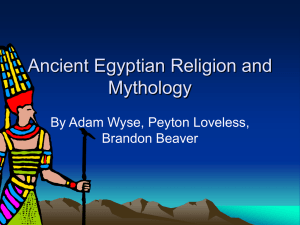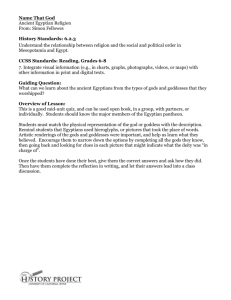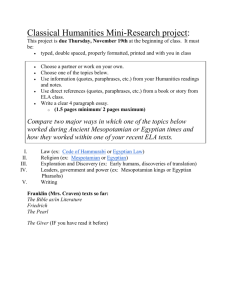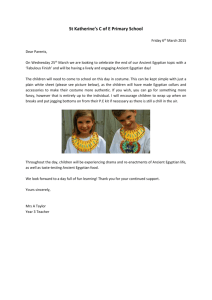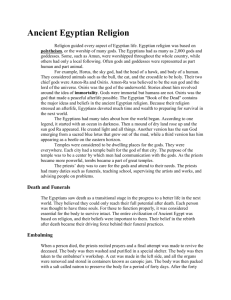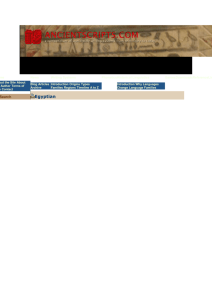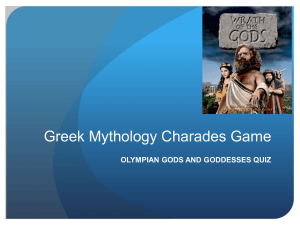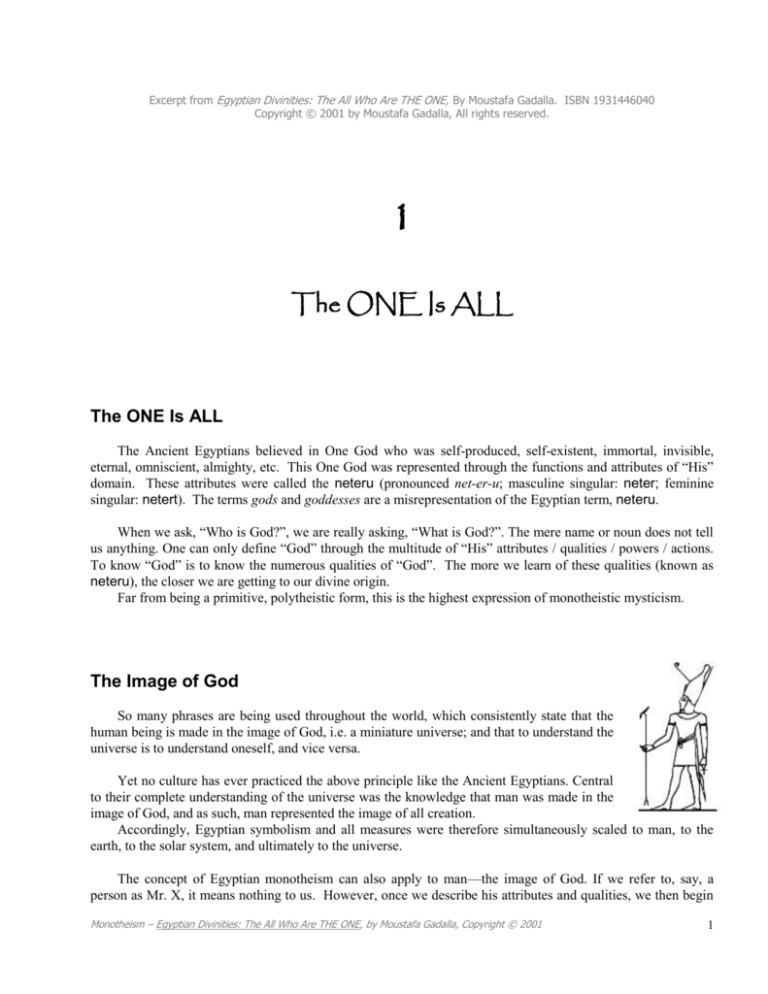
Excerpt from Egyptian Divinities: The All Who Are THE ONE, By Moustafa Gadalla. ISBN 1931446040
Copyright © 2001 by Moustafa Gadalla, All rights reserved.
1
The ONE Is ALL
The ONE Is ALL
The Ancient Egyptians believed in One God who was self-produced, self-existent, immortal, invisible,
eternal, omniscient, almighty, etc. This One God was represented through the functions and attributes of “His”
domain. These attributes were called the neteru (pronounced net-er-u; masculine singular: neter; feminine
singular: netert). The terms gods and goddesses are a misrepresentation of the Egyptian term, neteru.
When we ask, “Who is God?”, we are really asking, “What is God?”. The mere name or noun does not tell
us anything. One can only define “God” through the multitude of “His” attributes / qualities / powers / actions.
To know “God” is to know the numerous qualities of “God”. The more we learn of these qualities (known as
neteru), the closer we are getting to our divine origin.
Far from being a primitive, polytheistic form, this is the highest expression of monotheistic mysticism.
The Image of God
So many phrases are being used throughout the world, which consistently state that the
human being is made in the image of God, i.e. a miniature universe; and that to understand the
universe is to understand oneself, and vice versa.
Yet no culture has ever practiced the above principle like the Ancient Egyptians. Central
to their complete understanding of the universe was the knowledge that man was made in the
image of God, and as such, man represented the image of all creation.
Accordingly, Egyptian symbolism and all measures were therefore simultaneously scaled to man, to the
earth, to the solar system, and ultimately to the universe.
The concept of Egyptian monotheism can also apply to man—the image of God. If we refer to, say, a
person as Mr. X, it means nothing to us. However, once we describe his attributes and qualities, we then begin
Monotheism – Egyptian Divinities: The All Who Are THE ONE, by Moustafa Gadalla, Copyright © 2001
1
to know him. A person who is an engineer, a father, a husband, ... etc. does not have poly-personalities, but
rather a mono-personality with multiple functions/attributes. For the Ancient and Baladi Egyptians, the concept
of God is similar.
The logical (and only) way to explain anything to human beings is on human terms and in human form. As
such, the complicated scientific and philosophical information was reduced in Ancient Egypt to events—in
human images and terms.
Picturing the Divine Powers
In order to simplify and convey the scientific and philosophical meanings of the neteru (gods/goddesses),
some fixed representations were utilized. As a result, the figures of Auset (Isis), Ausar (Osiris), Amen, Heru
(Horus), Mut, etc., became the symbols of such attributes/functions/forces/energies.
These pictorial symbols were intended merely to fix the attention or represent abstract ideas, and were not
intended to be looked upon as real personages. As the saying goes, “a picture is worth a thousand words.”
Egyptian symbolism could be compared in some sense to modern day caricature.
Caricature uses symbols (such as Uncle Sam, Russian bear, British bulldog, etc.) to
represent concepts, ideas, nations, ...etc. A symbol reveals to the mind a reality other
than itself. For the informed, the cartoon can reveal, in legitimate symbolic form, the
totality of a given situation, in the eyes of the individual cartoonist. For those
unfamiliar with the cartoonist and his/her choice of symbols, the cartoon will be total
nonsense.
Practically all figures on the walls of Egyptian monuments are in profile form,
indicative of action and interaction between the various symbolic figures. A wide variety of actions in the forms
are evident.
A chosen symbol represents that function or principle, on all levels simultaneously—from the simplest,
most obvious physical manifestation of that function to the most abstract and
metaphysical. Without recognizing the simple fact about the intent of
symbolism, we will continue to be ignorant of the wealth of Egyptian
knowledge and wisdom.
In Egyptian symbolism, the precise role of the neteru (gods/goddesses)
are revealed in many ways: by dress, headdress, crown, feather, animal,
plant, color, position, size, gesture, sacred object (e.g., flail, scepter, staff,
ankh), etc. This symbolic language represents a wealth of physical,
physiological, psychological and spiritual data in the presented symbols.
Animal Symbolism
Egyptians’ careful observation and profound knowledge of the natural world enabled them to identify
certain animals with specific qualities that could symbolize certain divine functions and principles, in a
Monotheism – Egyptian Divinities: The All Who Are THE ONE, by Moustafa Gadalla, Copyright © 2001
2
particularly pure and striking fashion. As such, certain animals were chosen as symbols for that particular
aspect of divinity.
This effective mode of expression is consistent with all cultures. For
example, in the West they use expressions such as quiet as a mouse, sly
like a fox, ...etc.
The animal or animal-headed neteru (gods/goddesses) are symbolic
expressions of a deep spiritual understanding. When a total animal is
depicted in Ancient Egypt, it represents a particular function/attribute in
its purest form. When an animal-headed figure is depicted, it conveys
that particular function/attribute in the human being. The two forms of
Anbu (Anubis), in the two illustrations shown here, clearly distinguish
these two aspects.
[The particular qualities of the dog are described on page 100.]
Another example is the depiction of soul in Ancient Egypt, which is known as the ba. The ba is
represented as a human-headed bird, which is the opposite of the normal
depiction of neteru (gods/goddesses) as human bodies with animal heads—
in other words, as the divine aspect of the terrestrial. The ba is depicted as
a stork. The stork is known for its migrating and homing instinct, and is
also known worldwide as the bird that carries newborn babies to their new
families. The stork returns to its own nest with consistent precision—hence
a migratory bird is the perfect choice to represent the soul.
[Several examples of animal symbolism will be detailed throughout the book.]
The Nine Realms
Since Einstein’s relativity theory, it has been known and accepted that matter is a form of energy, a
coagulation or condensation of energy. The universe is basically a hierarchy of energies, at different orders of
density. Our senses are most familiar with matter—the densest form of energy.
This matrix of energies came as a result of the initial act of creation and the subsequent effects of the Big Bang
that created the universe. The hierarchy of energies is interrelated, and each level is sustained by the level below it. This
hierarchy of energies is set neatly into a vast matrix of deeply interfaced natural laws. It is both physical and
metaphysical.
The Ancient and Baladi Egyptians made/make no distinction between a metaphysical state of being and one
with a material body. Such a distinction is a mental illusion. We exist on a number of different levels at once,
from the most physical to the most metaphysical.
Ancient and Baladi Egyptians believe that the universal energy matrix consists of nine realms, which are
commonly classified as seven heavens (metaphysical realms) and two earths (physical realms). God lives in the
most distant heaven. Angels (neteru) inhabit heavens two through six. Ancestor spirits inhabit the heaven
nearest the two earths.
Monotheism – Egyptian Divinities: The All Who Are THE ONE, by Moustafa Gadalla, Copyright © 2001
3
The two earthly realms are commonly known as the Two Lands—the one we live in, and another one where
our identical twin (of the opposite sex) live. The two are subject to the same experiences from date of birth to
date of death. [More about this concept in Egyptian Cosmology: The Animated Universe, by same author.]
Working Together
The energies represented by the various neteru (gods/goddesses) rarely function individually, but are often
allied or fused with other neteru (gods/goddesses). The union of certain pairs of complementary
energies/attributes (masculine and feminine forms) result in a third energy/attribute. Trinities are sometimes
portrayed together as a single composite entity, sometimes separately, sometimes in binary form.
In human terms, a family consists of a man, a woman, and a child. The three are one unit—a family.
There are also binary relationships, such as: husband–wife (marriage), father–child (fatherhood), and
mother–child (motherhood).
Examples of trinities in Ancient Egypt are:
Atum–Shu–Tefnut
Ausar (Osiris)–Auset (Isis)–Heru (Horus)
Amen–Mut–Khonsu
Ptah–Sekhmet–Nefertum
Examples of binary action of neteru (gods/goddesses) in Ancient Egypt include:
Ausar (Osiris)–Auset (Isis)
Heru (Horus)–Ausar (Osiris)
Heru (Horus)–Set (Seth)
Heru (Horus)–Tehuti (Thoth)
Narration of Divine Powers
The cosmological knowledge of Ancient Egypt was expressed in story form, which is a superior means for
expressing both physical and metaphysical concepts. Any good writer or lecturer knows that stories are better
than exposition for explaining the behavior of things, because the relationships of parts to each other, and to the
whole, are better maintained by the mind. Information alone is useless, unless it is transformed into
understanding.
The Egyptian sages transformed common factual nouns and adjectives (indicators of qualities) into proper
but conceptual nouns. These were, in addition, personified so that they could be woven into narratives.
Storytellers were specially qualified people who bore an awesome responsibility of always being—Maa Kheru
(True of Voice).
Monotheism – Egyptian Divinities: The All Who Are THE ONE, by Moustafa Gadalla, Copyright © 2001
4
All Ancient Egyptian cosmic stories are embedded with the society’s social framework. In other words, the
society must conduct its practices in accordance with the same cosmic principles embedded in these stories.
The most common story to all Egyptians was that of Ausar (Osiris) and his family. There is not a single
complete Egyptian record of it, in all the recovered archeological findings. Our knowledge of this Model Story
comes from several versions that were written by the early Greek and Roman writers. The most common was
the one told by Plutarch.
A shortened version of the story of the Egyptian role model goes as follows:
The self-created neter (god) Atum spat out the twins Shu and Tefnut, who in turn gave birth to Nut (the
sky) and Geb (the earth/matter).
The union of Nut and Geb produced four descendants: Ausar (Osiris), Auset (Isis), Set (Seth), and NebtHet (Nephthys).
The story goes that Ausar (Osiris) married Auset (Isis), and Set (Seth) married Nebt-Het (Nephthys).
Ausar (Osiris) became King of the land (Egypt) after marrying Auset (Isis).
•
The story sets the basis for the matrilineal/matriarchal society. Auset (Isis) is the legal heiress.
•
Ausar (Osiris) and Auset (Isis) represent the principle of duality in the universe. With Ausar and
Auset, there is a harmonious polarity: brother and sister, twin souls, husband and wife.
•
The Ancient Egyptian word for brother and husband is the same word, sn, as well as the word for sister
and wife, sn.t. Therefore, we must be cautious when encountering sn and sn.t in certain texts, and not
to draw too many conclusions about incest and the like.
Both Ausar (Osiris) and Auset (Isis) were adored by the Egyptians. But their brother Set (Seth) hated
Ausar (Osiris) and was jealous of his popularity. Set (Seth) managed to pick a fight with Ausar (Osiris),
murdered him, and cut his body into 14 pieces (one for each night of the waning moon), which he scattered all
over Egypt.
Monotheism – Egyptian Divinities: The All Who Are THE ONE, by Moustafa Gadalla, Copyright © 2001
5
Ausar (Osiris) is associated with the waxing and waning of the moon and the cyclical nature of the
universe. [More about this is shown throughout this book.]
After Ausar’s death, Set (Seth), as the husband of Nebt-Het (Nephthys), became the King of Egypt, and
ruled as a tyrant.
Auset (Isis) went searching for the scattered parts of her beloved Ausar (Osiris), and with the help of her
sister, Nebt-Het (Nephthys), found every part of her husband’s body, except the phallus, which had been
swallowed by a fish. Auset (Isis) assembled his body, making the first Egyptian mummy. Both Auset (Isis)
and Nebt-Het (Nephthys) performed the necessary funerary rites and pleaded with Ausar (Osiris) to come back
to life—resurrection. [See a perfect illustration of both of them aiding the resurrection of Ausar (Osiris) on page 77.]
At the time of his death, Ausar (Osiris) and Auset (Isis) had no children, but by mystical means, the remembered body of Ausar (Osiris) was resurrected for one night and slept with Auset (this is equivalent to
being impregnated by the Holy Ghost). As a result, Auset (Isis) conceived a son. He was called Heru (Horus)
and was raised secretly in the marshes of the Nile Delta.
•
This action symbolizes reincarnation and spiritual rebirth—a key to understanding the Egyptian belief in
life after death.
•
The supernatural conception and the virgin birth of Heru (Horus) found their way into Christianity.
When Set (Seth) heard about the new child (Heru), Set went to kill the newborn. Hearing that Set (Seth)
was coming, Auset (Isis) hid her son in Uatchet (Buto).
This is strikingly similar to the later biblical story in which Herod, upon hearing about the birth of the
Jesus, set out to destroy all the newborn males.
As soon as Heru (Horus) had grown to manhood, he challenged Set (Seth) for the right to the throne.
Heru (Horus) and Set (Seth) had several battles and challenges. Finally, both Heru (the resurrected Ausar)
and Set (Seth) went to the council of neteru (gods/goddesses) to determine who should rule. Both presented
their cases.
The council of neteru (gods/goddesses) decided that Ausar/Heru should rule over the habitable/populated
areas, and Set (Seth) should rule over the deserts/wastelands.
•
Physical force did not decide the outcome of the “Great Quarrel” (the struggle between Heru and Set),
rather a jury of their peers (council of neteru) settled the matter.
•
Compromise and the principle of co-existence ended the conflict.
During the battle, Set (Seth) snatched away the eye of Heru (Horus), and threw it into
the celestial ocean. Tehuti (Thoth) recovered the eye that was later identified with the moon
and became a very popular symbol of protection. It was this Eye that Heru (Horus) used to
revive his sleeping father. Ausar (Osiris) was resurrected as a soul to rule the Netherworld.
Monotheism – Egyptian Divinities: The All Who Are THE ONE, by Moustafa Gadalla, Copyright © 2001
6
Ausar (Osiris) became the spirit of the past for the Egyptians, the neter (god) of the Dead, and the hope for
resurrection and afterlife.
Another version of the story indicates that as soon as she heard of her husband’s demise, Auset (Isis) set
out to search for the fragments of his body, embalmed them with the help of Anbu (Anubis), and buried them
wherever they were found and built shrines at these locations. According to this version of the story, the head of
Ausar (Osiris) was buried at Abtu (Abydos). The heart was buried on the island of Philae, near Sunt (Aswan).
The phallus was thrown into the Nile and was swallowed by a fish. For this reason the eating of fish was
forbidden to the Egyptian priests.
The similarities between the Egyptian Ausar/Auset/Heru (Osiris/Isis/Horus) Model Story and the Gospel
story are striking. Both accounts are practically the same, e.g. the supernatural conception, the divine birth, the
struggles against the enemy in the wilderness, and the resurrection from the dead to eternal life.
Monotheism – Egyptian Divinities: The All Who Are THE ONE, by Moustafa Gadalla, Copyright © 2001
7
2
Common Misrepresentations
Of the Divinities in Egypt
•
Egyptians had a confused religious system with an indefinite number of neteru (gods/goddesses).
4
There are an indefinite number of divinities (neteru), because the Divine has an endless number of
aspects/attributes.
•
There were “minor and major neteru (gods/goddesses)”.
4
A neter/netert (god/goddess) may have a minor role under certain conditions, however that does not make
the neter/netert (god/goddess) minor.
Neteru (gods/goddesses) are the forces of nature, and no one force is superior to others. A certain natural
force can be more prominent, depending on the time and place of its action. For example, the heat of the
sun has a major role on a midsummer day, and a minor role on a cloudy/rainy/snowy midwinter day.
•
A neter/netert (god/goddess) may have contradictory aspects.
4
“Contradictory aspects” can be interrelated. Take for example the aspect of motherhood, as represented by
a netert (goddess). A mother can be tender and can be ferocious, depending on the circumstances. These
are not contradictory qualities. Normally, a mother will be tender to her child, but if her child is threatened,
she becomes ferocious and will attack the outside threat.
•
A neter (god) may be represented in different forms or shapes.
4
The nature of neter/netert (god/goddess) may vary under changing conditions. In human terms, the nature
of water is present in different forms:
- as a vapor—in humid air.
- as a liquid—in rain.
- as a solid—in an ice cube.
Monotheism – Egyptian Divinities: The All Who Are THE ONE, by Moustafa Gadalla, Copyright © 2001
8
•
There were always power struggles between the different “cult centers.”
4
There were neither “political/religious struggles” nor “cult centers” in Ancient Egypt. Western academic
Egyptologists, who claim such nonsense, are projecting the history of the church onto the Ancient Egyptian
history.
The neteru (gods/goddesses) have complementary functions to each other. Since each neter/netert
(god/goddess) represents a function, s/he can be found in any temple/tomb/text. A neter/netert may have
a prominent (but never exclusive) role at any temple.
All temples were of equal importance, and the Egyptian Pharaohs performed the ritual services throughout
Egypt at all the temples.
•
The Egyptians gave a neter/netert (god/goddess) different names.
4
Names in Ancient Egypt were not just labels. A name was like a short resume or synopsis of the principle.
For example, the neter (god) Ra (Re) is described in the Unas Funerary (Pyramid) Texts:
They cause thee to come into being as Ra, in his name of Khepri.
Khepri is not just another label/name for Ra (Re). Khepri means coming into being. [More about Ra (Re) in
chapter 5, and more about Khepri in chapter 10.]
•
There was a shift in power among the neteru (gods/goddesses), associated with “historical events”.
4
The neteru (gods/goddesses) are the forces of nature. There are cyclical variations in nature. Therefore,
some neteru (gods/goddesses) were more prominent than others in certain times, not because of “political
shift”, but because of a shift in the zodiac ages. [For more information, see page 98 of this book and Egyptian
Cosmology: The Animated Universe - Second Edition, by same author.]
•
Egyptians categorized these neteru (gods/goddesses) into popular and sacred, local and regional, cosmic,
universal, major, minor, ...etc.
4
This is totally unfounded. Neteru (gods/goddesses) represent the different energies/powers that act and
interact in the creation and maintenance of the universe. Each situation determines which neter/netert
(god/goddess) has a major or minor role.
•
Egypt went through an “evolution” of religious beliefs, where the nature of the neteru (gods/goddesses)
changed over the centuries; they intermingled with outsiders’ beliefs, assimilating some divinities
(gods/goddesses), but also creating new ones.
4
This is sheer nonsense, fabricated by western academic Egyptologists, who ignore the facts of the time.
ALL early historians of the Greek and Roman times confirmed that the Egyptians are remarkably
traditionalist to a fault. For example, Herodotus (5th century BCE) stated in The Histories–Book Two,
Section 79,
Monotheism – Egyptian Divinities: The All Who Are THE ONE, by Moustafa Gadalla, Copyright © 2001
9
The Egyptians keep to their native customs and never adopt any from abroad.
In Book Two, Section 91, Herodotus states,
The Egyptians are unwilling to adopt Greek customs, or, to speak generally, those of any other
country.
Monotheism – Egyptian Divinities: The All Who Are THE ONE, by Moustafa Gadalla, Copyright © 2001
10
3
The Cycle of Neteru
The main theme of the universe is its cyclical nature. The NeTeRu are the forces of NaTuRe, which make
the world go around—so to speak. They are also the forces of nature that govern the miniature universe/image
of God/human being. All these neteru forces of NaTuRe are projected into each one of us.
The most obvious and universal cycle to humans is the solar cycle. The Egyptian model depiction of the
solar cycle is Nut, as the sky—shown above. The sun voyages the body of Nut from sunrise to sunrise. The
sun—born anew each morning, crosses the sky in the solar bark, ages, dies and travels through the underworld
during the night in a cycle of regeneration.
The human being goes through a similar cycle. One goes through the cycle of Birth—Life—Death—
Resurrection. The Ancient Egyptian transformational (funerary) texts always make reference to this similarity,
and illustrate the concept that Resurrection will follow Death; a new cycle will start—an everlasting new life.
Ground zero of the cycle was/is the crucial moment of sunrise. The Ancient Egyptians were
fascinated by this point of beginning.
The baboon represents this point of beginning extremely well. The baboon is almost human,
and as such, it represents this crucial moment that precedes the awakening of the sun. The baboon
represents this state in humans, just before they gain consciousness—the awakening.
Monotheism – Egyptian Divinities: The All Who Are THE ONE, by Moustafa Gadalla, Copyright © 2001
11
In concurrence with the Egyptians’ emphasis on the cyclical nature of the universe, we have thus arranged
over 80 of the most frequently encountered neteru (gods/goddesses) into seven stages of a single complete
cycle—from pre-dawn, through the successive generation and regeneration stages.
It should be emphasized that the role of a neter/netert (god/goddess) is often not limited to one particular
stage, even though such neter/netert (god/goddess) is listed here in one stage only.
Monotheism – Egyptian Divinities: The All Who Are THE ONE, by Moustafa Gadalla, Copyright © 2001
12

